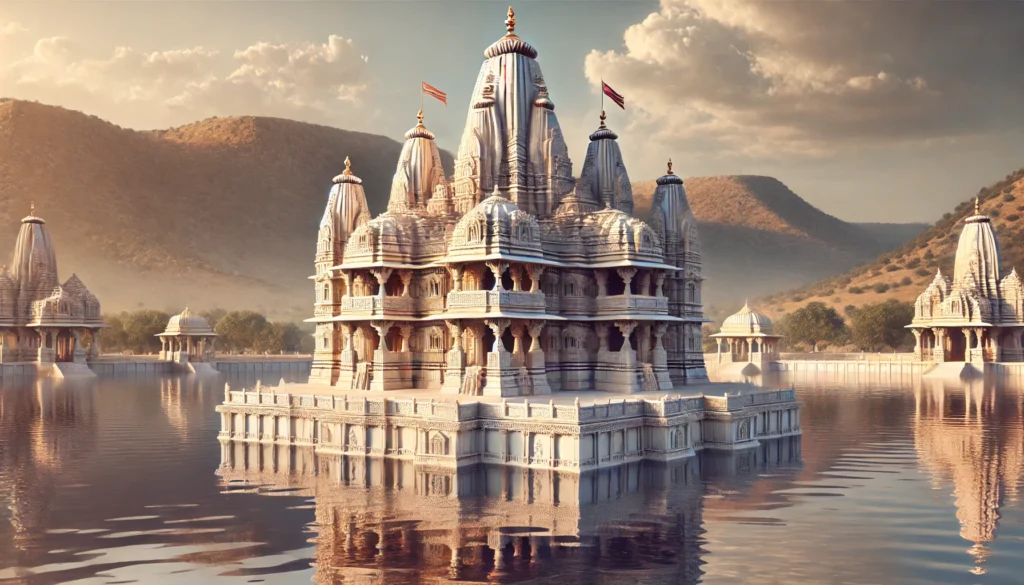Nestled in the scenic hills of the Aravalli range in Gujarat, the Ambaji Temple is one of the most revered shrines in India. This ancient temple is dedicated to Goddess Amba, an incarnation of Goddess Shakti, and holds immense significance in the spiritual and cultural landscape of India. The town of Ambaji, where the temple is located, is a bustling pilgrimage site visited by millions of devotees annually. This comprehensive guide to the Ambaji Temple will not only provide you with the historical and spiritual significance of the temple but also give practical tips for visiting, ensuring that your pilgrimage is a fulfilling and enriching experience.
Table of Contents
The Spiritual Significance of Ambaji Temple
The Ambaji Temple is considered one of the 51 Shakti Peethas in India, places where the body parts of Goddess Sati fell after the cosmic dance of Lord Shiva. Legend has it that the Heart of Goddess Sati fell at this very spot, marking it as one of the most powerful spiritual sites in India. This connection to the story of Shiva and Shakti makes Ambaji Temple a symbol of divine feminine power, attracting pilgrims from all over the country who come to seek blessings, spiritual healing, and inner peace.

Not only is this temple revered for its divine power, but it is also known for its absence of an idol in the sanctum sanctorum. Instead of a traditional deity, the main worship at Ambaji is directed to a holy yantra, a sacred geometric symbol representing the goddess. This unique feature adds to the temple’s mystical allure, making it a focal point of devotion and spiritual exploration.
The Mythological Connection
The history of the Ambaji Temple is deeply rooted in ancient mythology. According to Hindu legend, Goddess Amba helped her devotees in defeating the demons and restoring peace and harmony. The Skanda Purana and other Hindu scriptures mention Ambaji as the seat of Goddess Shakti. The temple is not just a place of worship but also a historical and cultural landmark that holds the essence of faith, power, and the triumph of good over evil.
Legend has it that Lord Krishna’s mundane ceremonies were conducted at this holy place by Guru Gargacharya. This further enriches the mythological and religious importance of Ambaji, making it not just a Shakti Peetha but a site of many divine events.
Architecture of Ambaji Temple
The architectural splendor of the Ambaji Temple is a visual treat for visitors. Constructed in Maru-Gurjara style, this temple reflects the traditional craftsmanship of ancient Gujarat. The intricate carvings and majestic stonework on the temple structure showcase a seamless blend of spirituality and artistry.
The temple’s white marble structure stands out against the green hills surrounding it. Its tall spires or shikhara rise to meet the sky, symbolizing the connection between the divine and the earthly. The gold-plated flag at the top of the spire is hoisted three times a day, signifying the ever-present divine energy in the temple.
The Holy Yantra
The most significant part of the temple is the Holy Yantra, representing the goddess herself. Situated inside the Gabbar hill, it is a triangular Yantra inscribed with sacred symbols, which is worshiped as the goddess. Interestingly, no images or idols are allowed to be carried inside the temple, and all prayers are offered directly to the yantra, which is considered highly powerful. Devotees are prohibited from photographing or sketching the sacred yantra, preserving the sanctity of the temple’s most important symbol.
Practical Tips for Visiting Ambaji Temple
Visiting a place as revered as the Ambaji Temple requires some preparation to make the most of the experience. Here are a few practical tips to help make your visit smooth and spiritually fulfilling:
- Best Time to Visit: The Navratri festival is the best time to visit the temple when the entire town lights up in celebration, and thousands of devotees gather for special prayers and rituals. The temple is also visited year-round, but Navratri holds special significance.
- Dress Code: Since Ambaji Temple is a deeply sacred place, it’s recommended to wear modest and traditional clothing. Avoid shorts, sleeveless tops, and revealing outfits.
- Accommodation: There are plenty of hotels and guesthouses in and around the town of Ambaji. Some devotees prefer to stay in the nearby city of Mount Abu, which is just a 45-minute drive from the temple. Make sure to book accommodation in advance during festival times to avoid any inconvenience.
- Transportation: Ambaji is well-connected by roads. You can travel by car, bus, or taxi from major cities like Ahmedabad (180 km), Udaipur (140 km), and Mount Abu (45 km). There are also regular buses from nearby towns.
- Temple Timings: The temple is open for darshan from 7 AM to 11:30 AM and again from 12:30 PM to 4:30 PM. The evening darshan starts from 7 PM to 9 PM. It’s advisable to visit early in the morning to avoid large crowds.
- Pooja and Rituals: Special Poojas are conducted during Navratri and on full moon days. You can also participate in Aarti sessions, which are held at specific times in the morning and evening. Be sure to check with the temple staff for the daily schedule of rituals.
For more information on booking and rituals at the Ambaji Temple, visit the official Ambaji Temple website for details.
Gabbar Hill: The Sacred Mountain
Just 4.5 kilometers away from the Ambaji Temple lies the Gabbar Hill, believed to be the original seat of Goddess Amba. According to legends, this is where the goddess revealed herself to her devotees. It is said that climbing the 999 steps to the top of Gabbar Hill provides a spiritually enriching experience. At the summit, there is a small shrine where devotees offer prayers and light a divine lamp (Akhand Jyoti) that burns continuously.
Gabbar Hill offers not only a divine experience but also a breathtaking view of the surrounding landscape. If you’re a nature lover, you’ll enjoy the scenic beauty as you ascend the steps, making it a journey worth remembering.
Major Festivals Celebrated at Ambaji Temple
Navratri at Ambaji Temple
The Navratri festival celebrated in honor of Goddess Durga is the grandest occasion at Ambaji Temple. Devotees from across the country flock to the temple during this nine-day festival to celebrate the divine feminine power. Garba, a traditional Gujarati dance, is performed in the temple complex every evening. The entire town of Ambaji is lit up during this period, making it the most vibrant time to visit.
Bhadarvi Poonam
Another major festival celebrated at Ambaji Temple is Bhadarvi Poonam, which falls in the Shravan month of the Hindu calendar. Thousands of devotees gather to offer prayers and seek blessings. Special processions, poojas, and rituals take place during this time.
Diwali Celebrations
The festival of Diwali, celebrated with much enthusiasm, is another time when the temple sees a surge in visitors. The temple is decorated with lights, and the Diwali Aarti is a sight to behold.
For those interested in planning their visit during any of these festivals, check out Gujarat tourism’s official website for festival schedules and additional information.
Conclusion: A Spiritual Experience Like No Other
Visiting the Ambaji Temple is more than just a religious pilgrimage—it is a journey to spiritual awakening and connection with the divine. The temple’s rich mythology, unique worship practices, and cultural significance make it one of the most revered places in India. Whether you’re seeking spiritual fulfillment, cultural exploration, or simply want to experience the serenity and beauty of the surroundings, Ambaji Temple has something for everyone.
Plan your visit today to experience the divine grace of Goddess Amba and immerse yourself in the rich heritage of Ambaji Temple. Make sure to climb Gabbar Hill, participate in the temple’s rituals, and witness the Navratri festival to truly grasp the essence of this sacred space.
